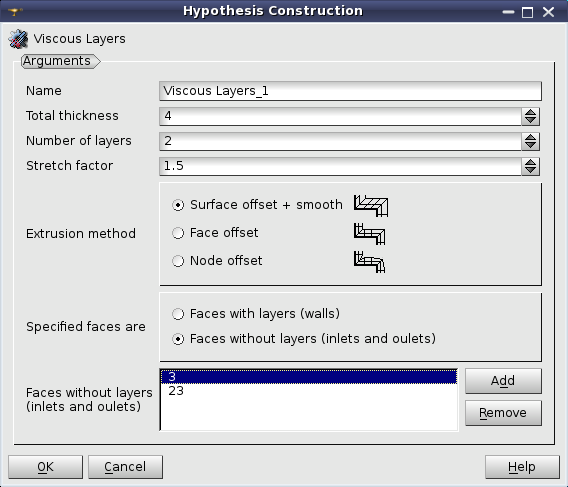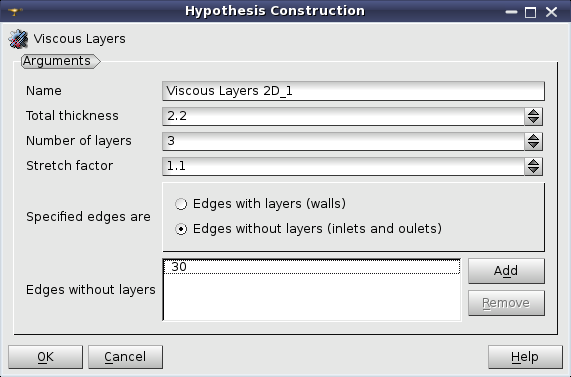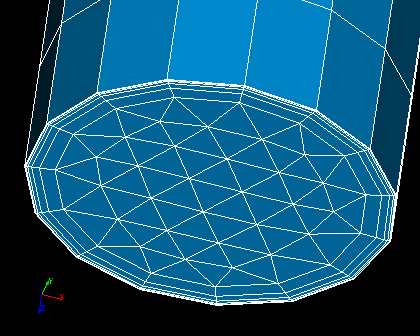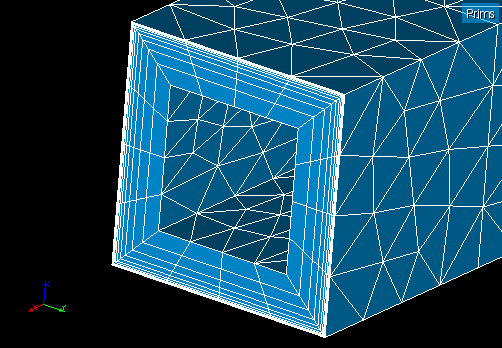Version: 8.3.0
Additional Hypotheses can be applied as a supplement to the main hypotheses, introducing additional concepts to mesh creation.
An Additional Hypothesis can be defined in the same way as any main hypothesis in Create Mesh or Create Sub-Mesh dialog.
The following additional hypothesis are available:
Propagation of 1D Hypothesis on opposite edges allows to mesh opposite sides of a quadrangle face and other adjacent quadrangles, using the same hypothesis assigned to only one edge.
Thus you define a sub-mesh on the edge where you define 1D meshing parameters and the Propagation hypothesis. These local meshing parameters will be propagated via opposite sides of quadrangles to the whole geometry, and this propagation stops at an edge with other local meshing parameters.
This hypothesis can be taken into account by Wire Discretization and Composite Side Discretization algorithms.
See Also a sample TUI Script of a Propagation hypothesis operation
Propagation of Node Distribution on Opposite Edges allows to propagate distribution of nodes onto an opposite edge. If a local hypothesis and propagation are defined on an edge of a quadrangular face, the opposite edge will have the same number of nodes and the same relations between segment lengths, unless another hypothesis has been locally defined on the opposite edge.
This hypothesis can be taken into account by Wire Discretization and Composite Side Discretization algorithms.
See Also a sample TUI Script of a Propagation hypothesis operation
Viscous Layers and Viscous Layers 2D additional hypotheses can be used by several 3D algorithms, for example Hexahedron(i,j,k), or 2D algorithms, for example Triangle (MEFISTO), correspondingly. These hypotheses allow creation of layers of highly stretched elements, prisms in 3D and quadrilaterals in 2D, near mesh boundary, which is beneficial for high quality viscous computations.



Faces/Edges with/without layers - defines geometrical faces or edges on which element layers either should be or should not be constructed, depending on the value of the previous parameter (Specified Faces/Edges are). Faces (or edges) can be selected either in the Object Browser or in the VTK Viewer. Add button becomes active as soon as a suitable sub-shape is selected.
If faces/edges without layers are specified, the element layers are not constructed on geometrical faces shared by several solids in 3D case and edges shared by several faces in 2D case. In other words, in this mode the element layers can be constructed on boundary faces and edges only, and are not constructed on internal faces and edges. There is an exception to this rule: if a hypothesis is assigned to a sub-mesh, the element layers can be constructed on boundary faces/edges of the shape of this sub-mesh, at same time possibly being internal faces/edges within the whole model.

If you use several hypotheses to define viscous layers on faces of one solid, keep in mind the following. Each hypothesis defines a set of faces with viscous layers (even if you specify faces without layers). The sets of faces with viscous layers defined by several hypotheses should not intersect, else the module won't add an hypothesis that is incompatible with another one.
Also you can't define different number of layers on adjacent faces of a solid.
This logic is also valid for the 2D hypothesis.

See also a sample TUI script of a Viscous layers construction.
Quadratic Mesh hypothesis allows to build a quadratic mesh (in which links between element nodes are not straight but curved lines due to presence of an additional mid-side node).
This 1D hypothesis can be taken into account by Wire Discretization and Composite Side Discretization algorithms. To create a quadratic mesh assign this hypothesis at mesh construction.
See Adding Quadratic Elements for more information about quadratic meshes.
This additional hypothesis can be used together with 2D triangulation algorithms. It allows 2D triangulation algorithms to build quadrangular meshes.
Usage of this hypothesis with "Quadrangle: Mapping" meshing algorithm is obsolete since introducing Quadrangle parameters hypothesis. Usage of this hypothesis with "Quadrangle: Mapping" meshing algorithm corresponds to specifying "Quadrangle Preference" transition type of Quadrangle parameters hypothesis.